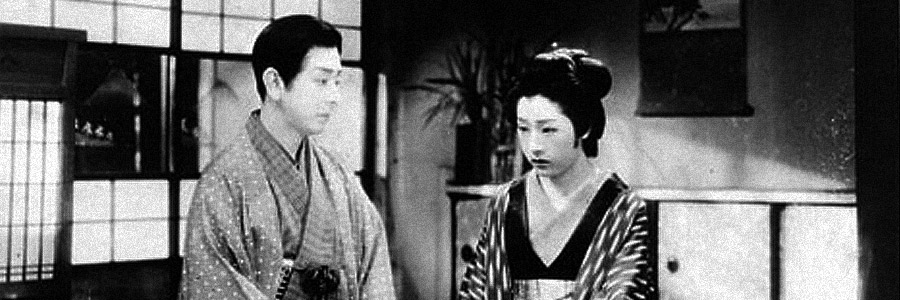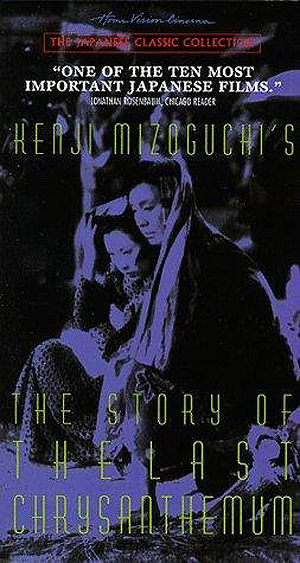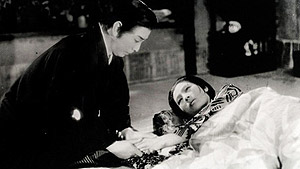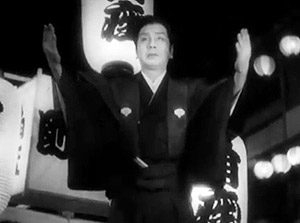
The Story Of The Last Chrysanthemums

THE STORY OF THE LAST CHRYSANTHEMUMS (MOVIE)
Films Inc.
Original release: October 13th, 1939
Running time: 142 minutes
Country of origin: Japan
Original language: Japanese
Director: Kenji Mizoguchi
Writers: Matsutar? Kawaguchi, Yoshikata Yoda, Shôfû Muramatsu
Cast: Shôtarô Hanayagi, Kakuko Mori, Kôkichi Takada, Gonjurô Kawarazaki

I’ve very little doubt that if the question “is fame more important than love?” was asked, most would reply “no”, but what happens when we take a closer look at our celebrity-obsessed culture? The word “love” is superficially overused and it often seems like it’s said only to create an image which then can be sold to the public. It’s a real surprise the contrast between love and fame, as well as person and celebrity, can feel so relevant in a film made as long ago as 1939.
These are the opposites that are dealt with in Kenji Mizoguchi’s The Story of the Last Chrysanthemums with the film’s narrative strings stretched to the limit by using a very clever mechanism with its characters. The film is also a noteworthy change from two of the director’s recent ‘troubled’ masterpieces, Osaka Elegy and The Sisters of the Gion, made three years earlier as he shifted his focus from gender to class and social obligations.
Even before the story gets started, we are in for a real treat. It takes place in 1888 and opens in a Kabuki theatre. We see a character on stage that might be familiar to perceptive viewers: with its white face and long black hair, it is the vengeful spirit the Japanese call Onryo. Most of us are familiar with this ghost from more recent Japanese horror films like Ju-on: The Grudge (2003) and Ringu (1998). The concept was first visualised in early Kabuki plays in the 17th century and to my knowledge, its first appearance on screen is marked in the opening of The Story of the Last Chrysanthemums. Almost as if foreshadowing Japanese horror 60 years later, the spirit on the stage says:
This brief moment with Onryo looking for revenge for the first time before a camera gives The Story of the Last Chrysanthemums a very special value and place in Japanese cinema.

When the play is over, we meet young Kabuki actor Kikunosuke (Shôtarô Hanayagi) who is expected to follow in the footsteps of his famous stepfather in an illustrious acting career. Kikunosuke is well liked and admired by everyone around him. I was surprised to see how he was surrounded, and almost under attack by geishas fighting over him, much like those screaming girls we see around famous and handsome up-and-coming male actors today. The depiction of Kikunosuke’s life as a spoiled playboy and his devoted female fans in the first act shows us today’s world of celebrity really isn’t all that different from those ‘good old days’.
There’s s a problem with all of this admiration though; no one dares to be honest with Kikunosuke about his craft and the truth is – he’s a terrible actor. With everyone praising him, he’s bound to be successful regardless of his talent – or the lack of it. Kikunosuke is shielded from reality by the wealth and social status of his family and therefore he makes no attempt to work hard and improve. He’s nevertheless suspecting that something’s wrong and is frustrated that the truth is being blocked by phoney praise.
It’s eventually revealed in one of Kenji Mizoguchi’s trademark long tracking shots. Otoku (Kakuko Mori), the wet-nurse of Kikunosuke’s baby stepbrother, joins him for a brief evening walk and she decides to tell him everything. She is gentle and yet strikingly honest about how bad he is and Kikunosuke is stunned – not really by the  truth, but rather Otoku’s honesty. He is immediately drawn to her and soon tells her she’s the first real friend he’s ever had. What follows is a great love story and tragedy as Kikunosuke defies his adopted father and leaves the family home to start his career from scratch with Otoku’s help and support.
truth, but rather Otoku’s honesty. He is immediately drawn to her and soon tells her she’s the first real friend he’s ever had. What follows is a great love story and tragedy as Kikunosuke defies his adopted father and leaves the family home to start his career from scratch with Otoku’s help and support.
Mizoguchi’s dealing with gender in The Story of the Last Chrysanthemums is very different from the ‘male guilt’ driven Osaka Elegy (1936) and The Sisters of the Gion (1936). The act of Otoku’s stepping outside the traditional role of a woman for the very first time in her life is actually shown in the film and I really liked the fact that it’s also a selfless deed. She takes a big risk by telling Kikusonuke about his weaknesses; he could’ve responded very differently and taken it an as insult, which would have consequences for Otoku. She shows great disrespect within the cultural traditions of the time and is rewarded for her actions.
The character mechanism to keep both fame and love floating in high contrast is achieved by Otoku’s devoted support for Kikunosuke’s acting career. Otoku started their relationship by confronting Kikunosuke with honest criticism and she  subsequently expresses much of her love by continuing to oversee his professional development. This dynamic between the couple creates a narrative of inherent tension.
subsequently expresses much of her love by continuing to oversee his professional development. This dynamic between the couple creates a narrative of inherent tension.
Not unlike Osaka Elegy and Sisters of the Gion, this film also ends with tragedy and pain for the female protagonist. However, the argument of ‘male guilt’ and ‘worship of womanhood’ that has an alienating effect between the two genders don’t apply to The Story of the Last Chrysanthemums. Otoku’s character is shown very much as Kikunosuke’s equal; he depends on her as much as she does on him.
The scene where she tells Kikunosuke he’s a bad actor is very interesting visually. Kikunosuke walks ahead of Otoku, but they soon swap places, she takes the lead, and in a physical sense as well. While Kikunosuke is naïve and makes it clear that Otoku is more important to him than acting, Otoku deceives him if she thinks it will help his career. This bothered me to a degree, but I recognise this excessive form of devotion from Japanese fiction and it made sense in the film’s own tragic way.
- Ooms, H (2008) Imperial Politics and Symbolics in Ancient Japan, University of Hawai’i Press
There are multiple reasons to appreciate The Story of the Last Chrysanthemums. Apart from an early appearance of Onryo, the vengeful spirit of Japanese folklore that’s haunting the screens of modern Japanese horror, we’re also treated to the Kabuki performances. These scenes are not only authentic but also lengthy in accordance with Kenji Mizoguchi’s use of long takes so we can sit back and enjoy Kikunosuke becoming an actor by following his stage performances along with Otoku.
More than anything, this is a beautiful love story that ends in a heartbreaking tragedy so well written and acted that The Story of the Last Chrysanthemums is without a doubt one of the great Japanese masterpieces.

Arpad Lukacs
Arpad is a Film Studies graduate and passionate photographer (he picked up the camera and started taking stills just as he began his studies of moving pictures). He admires directors that can tell a story first of all in images. More or less inevitably, Brian De Palma has become Aprad’s favourite filmmaker.
Then there’s Arpad’s interest in anime. He was just a boy when he saw Nausicaä of the Valley of the Wind on an old VHS and was hypnotised by the story of friendship, devotion and sacrifice. He still marvels at the uncompromising and courageous storytelling in Japanese anime, and wonders about the western audience with its ever growing appetite for “Japanemation”.
Have a look at Arpad's photography site, and you can follow him on Twitter @arpadlukacs.
© 2022 STATIC MASS EMPORIUM . All Rights Reserved. Powered by METATEMPUS | creative.timeless.personal. | DISCLAIMER, TERMS & CONDITIONS
HOME | ABOUT | CONTACT | TWITTER | GOOGLE+ | FACEBOOK | TUMBLR | YOUTUBE | RSS FEED
CINEMA REVIEWS | BLU-RAY & DVD | THE EMPORIUM | DOCUMENTARIES | WORLD CINEMA | CULT MOVIES | INDIAN CINEMA | EARLY CINEMA
MOVIE CLASSICS | DECONSTRUCTING CINEMA | SOUNDTRACKS | INTERVIEWS | THE DIRECTOR’S CHAIR | JAPANESE CINEMA





